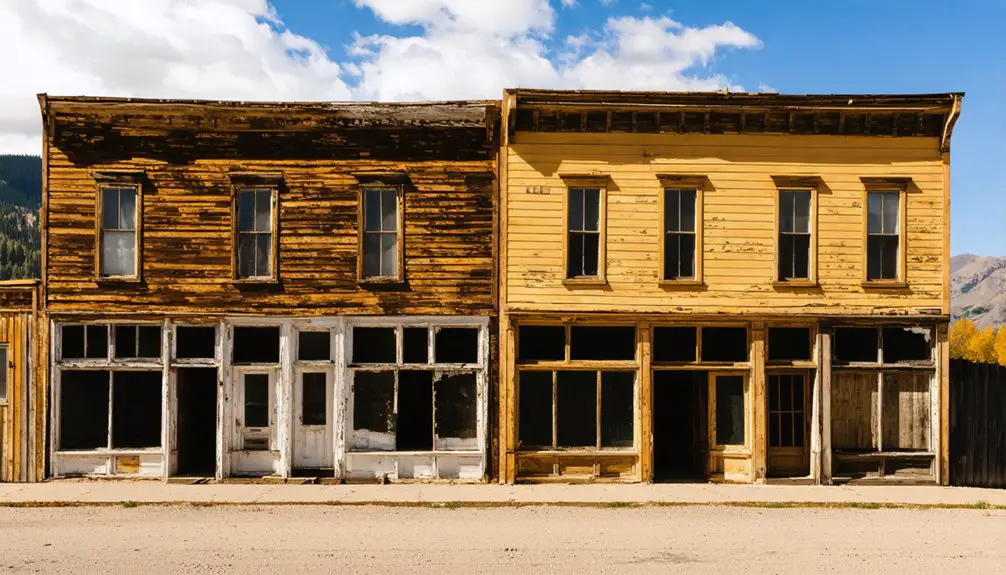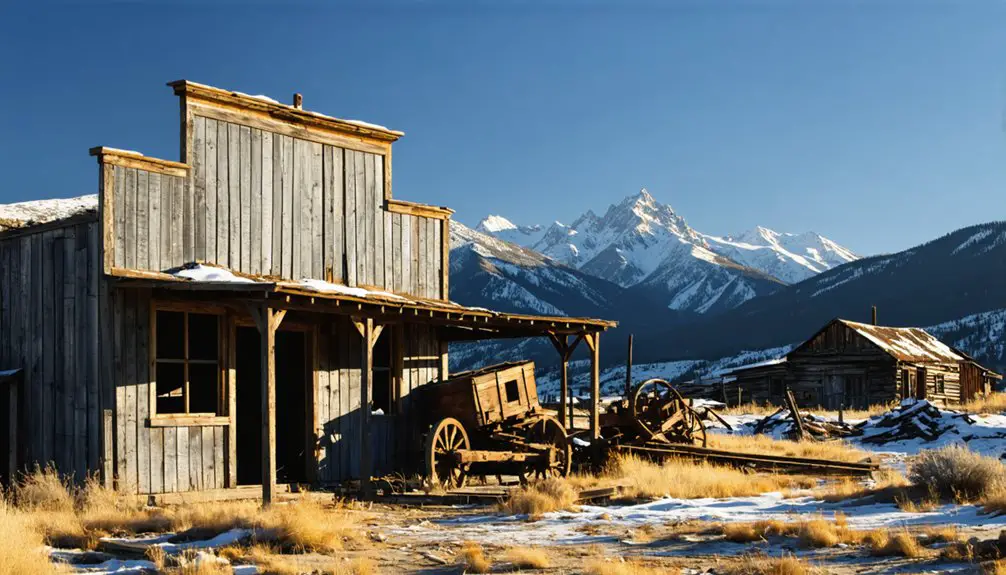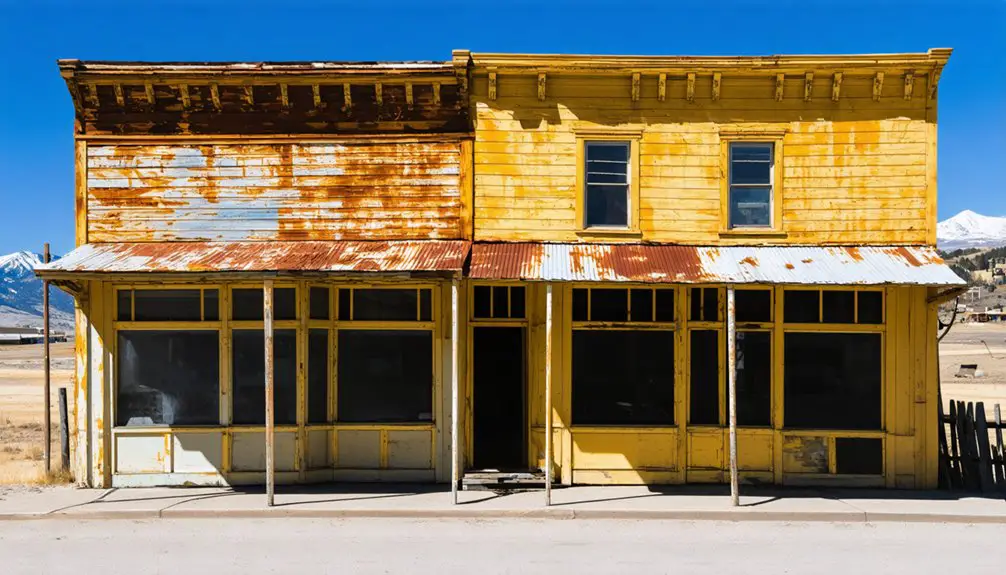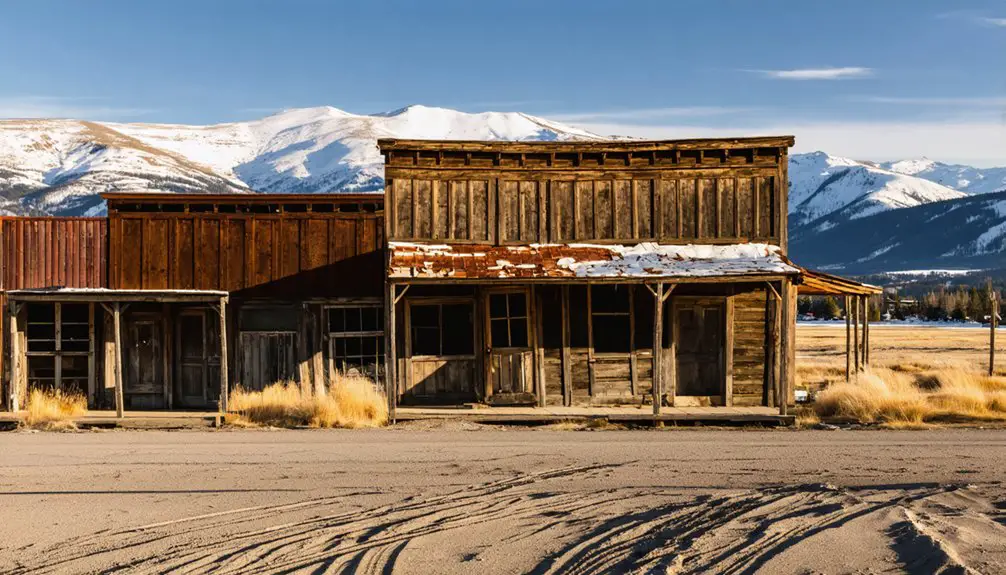You’ll discover Yellowstone City as a proof of Montana’s gold rush era, established in 1864 when four Confederate veterans struck gold in the Big Belt Mountains. At its peak, this boomtown housed 10,000 residents living in simple log structures, with the McLaren Gold Mines Company processing 185 tons of ore daily. By 1910, dwindling resources and harsh conditions led to complete abandonment, though scattered remnants still tell tales of frontier life and mining prosperity.
Key Takeaways
- Yellowstone City became a ghost town by 1910 after mining operations failed and residents abandoned the settlement due to economic collapse.
- Founded in 1864 following major gold discoveries, the town rapidly grew to 10,000 residents during its peak mining period.
- The settlement originally consisted of 75 log structures and relied on basic amenities like creek water and wood stoves.
- McLaren Gold Mines Company operated substantial mining operations, processing 185 tons of ore daily before accumulating devastating debt.
- Today, only scattered remnants and archaeological evidence remain of the original 1864 settlement in Park County, Montana.
Origins and Gold Rush Settlement in 1864

Three major gold discoveries in 1864 transformed Montana Territory and led to the establishment of Yellowstone City Park County.
The 1864 gold rush reshaped Montana’s destiny, as three major discoveries sparked the birth of Yellowstone City Park County.
You’ll find that while gold’s presence was known since Pierre deSmet’s earlier discovery near Virginia City, it remained secret to protect Native lands until renewed discoveries sparked a rush of settlers and prospectors into the region.
In the fall of 1864, you’d have witnessed four former Confederate soldiers striking gold in a gulch on the Big Belt Mountains’ west-facing slopes.
When William J. Baker unearthed a grain-of-wheat-sized nugget at their camp, it triggered a flurry of claim recordings.
The area quickly grew to become home to 10,000 miners and settlers at its peak.
Meanwhile, the Four Georgians’ Last Chance Gulch discovery near Helena yielded an astounding $19 million in gold, establishing essential settlement patterns that would shape Montana’s development for years to come.
Many prospectors traveled to Montana via Fort Benton on the Missouri River, bringing tools and supplies for their mining operations.
Life in Early Yellowstone City
While prospectors flocked to Yellowstone City in search of riches, they’d quickly discover the harsh realities of frontier life in this remote Montana settlement.
You’d find yourself living in one of 75 simple log huts, hauling water from nearby creeks and enduring brutal winter hardships with only wood stoves for warmth.
Your social life would revolve around the rough-and-tumble saloons and makeshift hotels, where community gatherings and occasional dances offered brief respites from the daily grind.
You’d rely on horse-drawn wagons along dirt roads for transportation, and the essential ferry at Benson’s Landing for supplies.
Trading posts stocked basic necessities, but you might need to barter when cash ran scarce. Like many mining settlements that followed the discovery of Gold at Gold Creek in 1858, survival required resourcefulness and adaptability.
Native American neighbors, particularly the Crow, sometimes shared survival knowledge that proved invaluable in this unforgiving territory.
The settlement grew rapidly after several hundred miners worked claims by fall 1864.
Mining Operations and Economic Activities

As the 1870s ushered in Montana’s mining era, prospectors descended upon Republic Mountain and Miller Mountain near Soda Butte Creek, establishing what would become a diverse mining landscape around Yellowstone City.
You’d have witnessed mining techniques evolve from simple placer operations to sophisticated open-cut mining. The McLaren Gold Mines Company’s operation processed 185 tons of ore daily, yielding 60,000 ounces of gold, 170,000 ounces of silver, and 4 million pounds of copper. Local miners utilized Bear Gulch water supply through over 3000 feet of ditch construction between 1875-77.
Early miners used mule-drawn arrastras before advancing to five-stamp combination mills. Economic fluctuations, like the Panic of 1893, triggered boom-and-bust cycles that shaped the region’s destiny.
Infrastructure expanded with power plants, smelters, and aerial tramways, though some projects remained unfinished. The Discovery Mining Company and other ventures continued operations into the mid-20th century, until environmental concerns curtailed further development.
Decline and Abandonment
The economic importance that drove Yellowstone City’s mining boom wouldn’t last forever. As coal deposits dwindled and market demands shifted, the town faced a devastating economic collapse by the early 1900s. Like many ghost towns in Montana, Yellowstone City’s decline mirrored the pattern seen across the region’s mining settlements.
The company accumulated massive debts of $90,000 to miners and investors before its closure. You’d have witnessed the rapid community decline as the Anaconda Copper Mining Company reduced its coal and coke demands.
Key factors that sealed Aldridge’s fate:
- Exhaustion of rich coal veins and falling coal prices
- Closure of crucial infrastructure like coke ovens and power plants by 1910
- Mass exodus of residents due to lost jobs and harsh living conditions
- Geographic isolation at 6,427 feet elevation
- Withdrawal of essential services including railroad, schools, and postal operations
The harsh Montana winters and remote location made it impossible to attract new businesses, ultimately leading to complete abandonment around 1910.
Historical Legacy and Present-Day Remnants

Standing as a testament to Montana’s mining heritage, Yellowstone City’s historical legacy endures through scattered remnants and archaeological evidence near the Yellowstone River corridor.
You’ll find few original structures from the 1864 settlement that once boasted 75 cabins during its gold mining heyday.
The site’s cultural significance extends beyond its physical remains, marking an important chapter in Montana’s frontier development. After the Sioux War ended, permanent settlers began establishing homes in the region in 1877.
Montana’s frontier story lives on through Yellowstone City’s legacy, enriching our understanding of the territory’s transformative settlement period.
While the original boomtown has vanished, nearby communities like Gardiner preserve elements of the region’s early settlement phase.
The historic Bozeman Trail‘s path still winds through the area, reminding you of the crucial transportation routes that shaped the region.
Archaeological findings continue to reveal insights into the area’s diverse history, from Native American presence to the dynamic period of European-American settlement.
Frequently Asked Questions
Were There Any Major Conflicts Between Native Americans and Yellowstone City Settlers?
You’d find surprisingly few direct settler conflicts in Yellowstone City, though Native American treaties sparked tensions nearby, with most major battles occurring around the broader Yellowstone region, not the city itself.
What Was the Average Temperature and Climate in Yellowstone City?
You’d experience average temperatures ranging from 9°F in winter to 75°F in summer, with cold, snowy winters and mild, dry summers typical of the seasonal climate in this high-altitude mountain region.
Did Any Famous Outlaws or Historical Figures Visit Yellowstone City?
While outlaw legends and historical visits shaped nearby Virginia City and Bannack, you won’t find direct records of famous outlaws or notable figures specifically visiting Yellowstone City in the available historical documentation.
How Did Residents Handle Medical Emergencies and Healthcare in Yellowstone City?
With no formal hospitals until the late 1800s, you’d rely on traveling doctors, local midwives, and neighbors for medical facilities. During healthcare challenges, you’d use herbal remedies or journey to larger settlements for treatment.
What Games and Entertainment Activities Were Popular in Yellowstone City?
You’d find a lively mix of recreational activities like poker, faro, and horse racing, plus cultural pastimes including dance socials, music shows, storytelling nights, and traveling theater performances for entertainment.
References
- https://en.wikipedia.org/wiki/Park_County
- https://parklocal.org/community/location/
- https://www.parkcounty.org/History/
- https://www.parkcounty.org/Yellowstone-Gateway-Museum/Glimmers-Of-History/
- http://genealogytrails.com/mon/park/towns.html
- https://mhs.mt.gov/education/textbook/chapter6/Chapter6.pdf
- https://discoveringmontana.com/history-of-the-gold-rush/
- https://www.clengpeerson.no/gold-discovery-established-meagher/
- https://www.wyohistory.org/encyclopedia/bridger-trail
- http://savagesandscoundrels.org/places/1864-gold-discovered-in-montana-territory/



